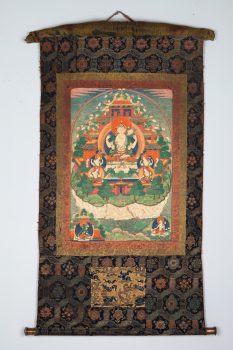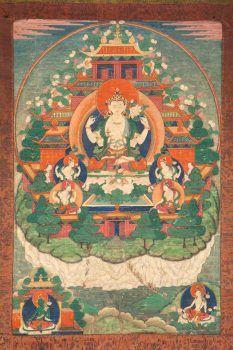Tibet
late 18th–early 19th century



Tibet
late 18th–early 19th century



Avalokiteshvara, the bodhisattva of compassion and the patron deity of Tibet, presides over his celestial dwelling of Mount Potalaka, believed to be an island off the coast of Western India. Adorned in silks and jewels, the four-armed Avalokiteshvara holds crystal rosary beads in his upper right hand and a lotus flower in his upper left, both signifying purity. His other pair of hands folded at the heart in a gesture of salutation. Green Tara, saviour from fears, is seated in her pure realm of Sandalwood Grove in the lower left corner, and in the lower right is Padmapani, another form of Avalokiteshvara. Both are deities closely related to the central figure. Unique details punctuate this resplendent scene—tiny figures climb the rope and cross the bridge toward Potalaka, representing the wish of Buddhists to attain rebirth in this realm, and a self-arisen image of Avalokiteshvara carved in a rock formation appears in front of the open gate. The silk brocade border reinforces the vivid colors and the images of the painting, extending outward to engage viewers to enter the pure realm themselves. Interestingly, Japanese Buddhists espoused rebirth in Potalaka as an easier path to liberation than Buddha Amitabha’s Sukhavati.
A meditation technique primarily used in tantric practice that involves imagining a deity in one’s mind or imagining oneself becoming a deity and carrying out various activities. Such techniques are intended to help a practitioner transform ordinary perception and achieve enlightened qualities.
The cultivation of a strong aspiration to help sentient beings overcome suffering. In Buddhist Mahayana teaching, compassion is the seed for attaining full enlightenment.
The central goal of Buddhism is the liberation of all beings from suffering and the cycle of life, death, and rebirth, known as samsara, through applying the teachings of the Buddha.
Beings who aspire to become fully awakened like the Buddha and are dedicated to helping others on the path to enlightenment.
Today, Tibetans primarily inhabit the Tibetan Plateau, situated between the Himalayan mountain range and the Indian subcontinent to the west, Chinese cultural regions to the east, and Mongolian cultural regions to the northeast. During the 7th to 9th century, Tibetan rulers expanded their empire across Central Asia, and established Buddhism as the state religion.
Get the latest news and stories from the Rubin, plus occasional information on how to support our work.